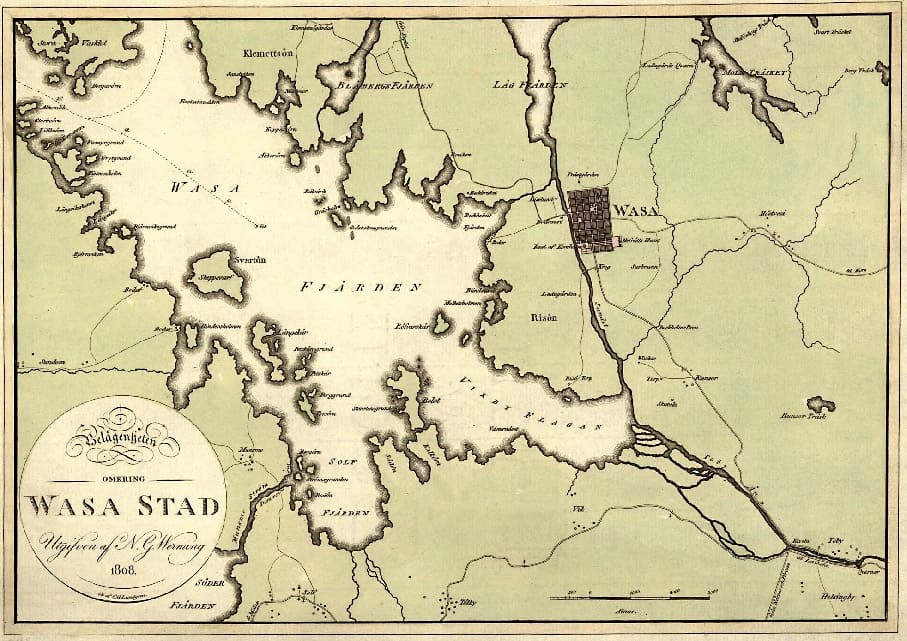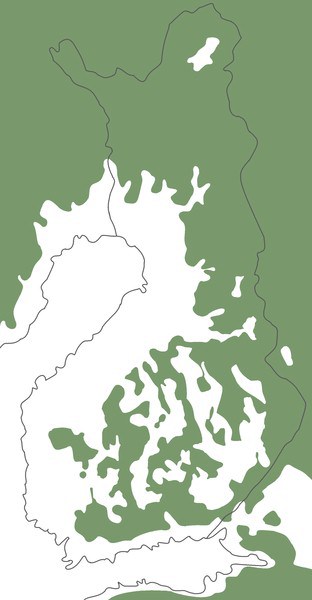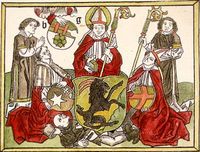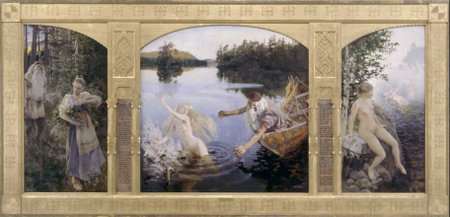BASIC TIMELINE FOR VAASA’S HISTORY.

As Vaasa has had two locations in its history, I have added the prefix (old) in this timeline when referring to the original site (now called Vanha Vaasa – which means Old Vaasa anyway). The original town was called Korsholm (in Finnish Mustasaari) and was once prosperous and an important port. However, land-rise at a rate of 10cm per year, and increasing ship dimensions, had already caused the building of a new harbour at Palosaari. The great fire of 1852 was the final straw and the new town was built seven kilometres to the north-west, on higher ground with deeper water.
560 million years BP (before present) – a meteorite of unknown size slams into the shallow sea 10km SSW of where Vaasa now lies, leaving a crater five and a half kilometres wide and 300 metres deep (which subsequently filled with sandy deposits). Unfortunately, nobody was around to record the event.
20,000-10,000 BP – The ice age reached its peak and the ice begins to retreat. At its greatest the ice sheet, centred on the Kvarken, had been three kilometres thick and had pressed the land deep under the sea. Obviously, in human terms, the ice took a very long time to melt, and this also happened on an irregular schedule, depositing its materials in ridges (De Greer Morains). The ice is long gone, but the land continues to rise at a rate of about 8mm per year – pretty fast in geological terms. This phenomenon provides new land at a rate of 300 hectares/750 acres per year. This process has been documented by the excellent Terranova Exhibition in Vaasa.

1O,000 BP – Finland as it was then.
1100s – At around this time Swedish crusaders enter what must have been a largely forest and village culture, with no central government. They brought their own culture and, of course, Christianity.

1156 – January 20 – According to legend, freeholder Lalli slays English crusader Bishop Henry (allegedly Bishop of Uppsala) with an axe on the ice of the lake Köyliönjärvi in Finland.
1300’s – Vaasa’s history begins at the beginning of the 1300’s, when seagoers arrived from Norrland and landed on a long, stringy, forested, and presumably uninhabited island. It must be remembered that, at that time, the whole area between the modern Vaasa and (Old) Vaasa was an archipelago that reached far inland.
1323 – The Swedes annex Finland and rule for the next 485 years.
1350’s – Saint Mary’s Church is built.
1370’s – The fortress at Korsholm is built.
1539 – MAP of Scandinavia filed in Venice at the time.
1550 – Helsinki, as it is now, was founded as Helsingfors by the Swedish king.
1606 – October 2nd – King Charles IX founded the town of (Old) Vaasa.
1683 – The three-subject or ‘trivial’ school moved from Nykarleby to (Old) Vaasa.
1687 – A new schoolhouse is built.
1700’s – MAP and article link to external site (in Finnish)
1715 – About this time Vaasa became embroiled in an international war between the Swedish, Russian and German empires. The town was sacked, the merchants’ fleets burnt, and crop failure added to the disaster – most of the population fled to Sweden.
1765 – Vaasa receives Staple Right (a kind of favoured trading position), trade and seafaring flourish, and many merchants become wealthy from the export of tar, pitch, grain, butter, pelts, boards and twine.
1776 – The Court of Appeal was built in (Old) Vaasa by Gustavus III, the second Court of Appeal in Finland. It was designed by superintendent C.F.Adelcrantz and completed in 1786.
1793 – The population of (Old) Vaasa was 2,178.
1794 – Finland’s first library is founded in (Old) Vaasa.
1808 – MAP
1808 – The Russians invade Sweden with a little help from Napoleon. At midsummer, once again the town is destroyed. The Swedish Auxiliaries fought back against Russian invaders, and about 400 soldiers fell in battle. Enemy soldiers sacked the town for three days and many of the population died.
1809 – Finland is ceded to Russia by the Swedes, but the Finns keep a lot of autonomy, including their own legal system and religion, and do not have to participate in Russian military service.
1812 – Helsinki becomes capital under the Swedish name Helsingfors – population at the time of about 560,000.

1835 The first edition of the Kalevala appeared, compiled and edited by Elias Lönnrot on the basis of the epic folk poems he had collected in Finland and Karelia which had been part of the oral tradition among speakers of Balto-Finnic languages for two thousand years.
1840 – Picture of Vanha Vaasa.
Mid 1800’s – C.G. Wolff builds a fleet of sailing ships in (Old) Vaasa, which at the time was the biggest private fleet in the whole in the northern countries.
1845 – The canal project, designed to improve access to the sea from the ever-rising (Old) Vaasa, is finished, only seven years before the fire which spurred the move to the Klemetsö peninsula. It is fascinating to see how the canal has developed over the years, and it is now, in 2010, being dredged again. Click HERE to see an album of much more recent pictures.
1852 – The town of (Old) Vaasa was almost totally destroyed by fire on August 3. The Court of Appeal is used as a church for the Korsholm congregation. In this year the population stood at 3,200.
1862 – Vaasa was rebuilt on a new site, on a peninsular 7km north of the ruins, and is where Vaasa stands today. The construction of Vaasa Church was also started, the church being consecrated four years later in 1866.
1880’s – The Golden Age of Finnish Art (external link)
1893 – A new harbour (number 4 so far) is opened for business on Vaskiluoto.
1896 – MAP
1899 – Russian Tsar Nicholas II starts the Russification of Finland. Finnish men were conscripted into the Russian Army, Russian was declared as the offical language. But the Finns did not take this lying down and started a campaign of protests and civil disobedience.
1902 – MAP
1906 – Finnish women get to vote, a first in Europe.
1910 – MAP
1917 – The Russians have a revolution and Finland takes the opportunity to declare independence.
1918 – Civil war breaks out between the Bolsheviks (Red Guards) and the right-wing government (White Guards). General Carl Gustaf Emil Mannerheim leads the whites to victory, but not without heavy losses. During this war, Vaasa was the capital of Finland from 29th January to 3rd May (1918). As it had become impossible to govern from Helsinki, the senate moved to Vaasa, where the Whites were strong. The senate held its sessions in the Town Hall.
1919 – Finland becomes a republic. Kaarlo Stahlberg becomes first president.
1920’s – One of the largest drainage projects in Europe creates 5,700 acres of fertile fields around the Söderfjärden meteorite site.
1920’s – Here are some examples of beautiful BANKNOTES from the period. For more information and examples click on the link to go to the Bank of Finland.
1922 – MAP of Suvilahti and Patteriniemi.
1930’s – Aerial Photos of Vaasa.
1939 – Outbreak of World War II. Finland declares its neutrality. In November the Soviet Union invades. The Winter War begins.
1940 – Despite fierce resistance, the Finns are forced to concede. The Treaty of Moscow gives around 10% of Finnish territory to the Soviet Union.
1941 – MAP
1941 – June – Germany attacks the USSR. Finland launches a military campaign to retake territory lost under Treaty of Moscow. December – Britain declares war on Finland.
1944 – The Red Army invades. An armistice is signed in September, but Finland cedes more land to the Soviet Union and has to pay hundreds of millions of dollars in war reparations.
1947 – A peace treaty is signed between Finland and the Soviet Union.
1948 – 6th April – Finnish Prime Minister Mauno Pekkala and Soviet Foreign Minister V.M.Molotov sign the ‘Treaty of Friendship, Co-operation and Mutual Assistance’ between Finland and the Soviet Union which, among other things, bound Finland to resist any attack through Finnish territory on the Soviet Union. This agreement lasted until September 21st 1990, at which time Finland unilaterally declared that the pact no longer had meaning, in the face of the collapse of the Soviet Union.
1950 – Urho Kekkonen becomes prime minister. His diplomatic approach to the USSR is one of friendship and co-operation.
1952 – The payment of war reparations is finally completed.
1955 – Finland joins the United Nations and the Nordic Council.
1956 – Urho Kekkonen becomes president and there is a general strike.
1973 – Trade agreements are signed with the European Economic Community and Comecon.
1989 – Soviet Union recognises Finnish neutrality.
1990 – Economic difficulties as former Soviet and eastern European markets collapse.
1991 – Centre Party coalition elected. Austerity measures introduced.
1992 – Friendship treaty with Soviet Union of 1948 declared null and void. New treaty with Russia involves no military agreements. Finland applies for membership of the European community.
1995 – Finland becomes member of the European Union. The social democrats emerge as strongest party in elections and form a “rainbow coalition” government with Paavo Lipponen as prime minister.
2000 February – Tarja Halonen elected as Finland’s first female president.
2002 January – Euro replaces the Finnish mark.
2006 January – Tarja Halonen re-elected for second term as president. Vaasa celebrates its official 400 years of history (and the Vaasa News Pages are born).
2006 May – Hell freezes over and Finland’s Lordi wins the European Song Contest!
2008 – The National Housing Exhibition attracts 141,000 visitors to the Vaasa suburb of Suvilahti.



